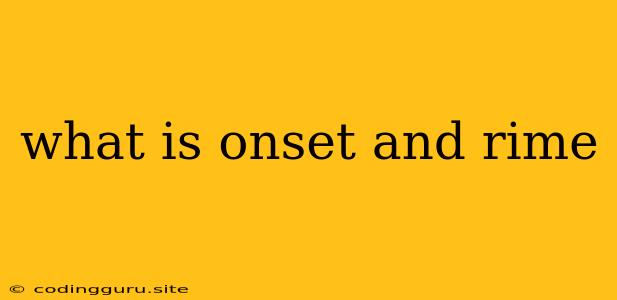What is Onset and Rime?
Understanding the building blocks of words can be a fun and effective way to enhance reading and spelling skills. Onset and rime are two important concepts that help break down words into their smaller parts. But what exactly are they?
Onset refers to the initial consonant sound or sounds of a syllable. Think of it as the "beginning" of the word. For example, in the word "cat," the onset is "c." Similarly, in "splash," the onset is "spl."
Rime on the other hand, is the vowel sound and any consonant sounds that follow the onset. In simple terms, it's the "ending" of the word. In "cat," the rime is "at." In "splash," the rime is "ash."
Why is understanding onset and rime important?
- Decoding Skills: When children learn to recognize onset and rime patterns, it helps them decode new words more easily. For instance, once a child learns the rime "at" in "cat," they can easily decode other words with the same rime, such as "bat," "hat," "mat," and so on.
- Spelling: Recognizing the onset and rime helps children understand the spelling of words. They can break down words into their components, making it easier to remember the correct spellings.
- Phonics: Onset and rime are fundamental to understanding phonics, the relationship between letters and sounds. By practicing with onset and rime, children develop strong phonics skills, which are crucial for reading fluency and comprehension.
How can you teach onset and rime to children?
Here are some fun and engaging activities:
- Picture Sorting: Show children a series of pictures and ask them to sort them based on the onset or rime. For example, you can ask them to group pictures of "cat," "hat," and "bat" because they all have the same rime.
- Rhyme Games: Play games that involve rhyming words. This can be as simple as asking children to identify words that rhyme with "cat" or creating a rhyming story together.
- Sound Manipulation: Practice manipulating sounds within words. You can ask children to change the onset of a word, such as changing "cat" to "rat" or "sat."
- Word Building: Use letter tiles or magnetic letters to build words together. Encourage children to focus on the onset and rime as they build words.
- Flashcards: Use flashcards with words divided into their onset and rime. For example, "c" and "at" for "cat" can be written on separate flashcards. Children can then use the flashcards to practice blending sounds and building words.
Example of Onset and Rime in Action:
Let's take the word "sail."
- Onset: "s"
- Rime: "ail"
Now, let's see how this understanding can help in decoding and spelling other words:
- Decoding: If a child knows the onset and rime of "sail," they can easily decode other words with the same rime, such as "nail," "tail," "pail," and so on.
- Spelling: If a child is asked to spell "pail," they can break it down into its components: the onset "p" and the rime "ail." This can help them remember the correct spelling.
Conclusion:
Onset and rime are essential building blocks for literacy development. By teaching children to recognize and manipulate these elements, we can help them become more confident and skilled readers and spellers. The activities suggested above are just a few examples of how to make learning onset and rime fun and engaging. With a little creativity and patience, you can help children master these important concepts and embark on a journey of lifelong literacy.
